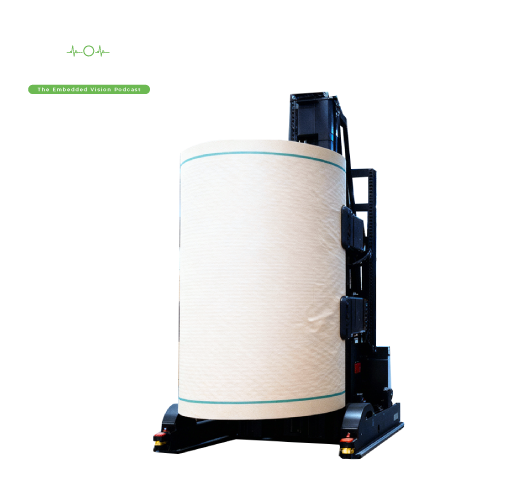Welcome to Vision Vitals, e-con Systems’ very own podcast.
Today, we take a close look at GMSL cameras and how they enable Automated Guided Vehicles to operate safely across long cable distances in high-interference environments.
In modern warehouses and factories, AGVs depend on real-time video for navigation and safety. Yet they move through zones filled with vibration, electrical noise, and metal structures that can disrupt signals.
To discover how GMSL cameras overcome those challenges, we’re joined by our expert from e-con Systems.
Good to have you back.
Glad to join again. As you mentioned, GMSL technology has indeed become a trusted option for AGVs.
Many people hear about GMSL in automotive applications. How does it translate to AGVs?
Speaker:
GMSL stands for Gigabit Multimedia Serial Link. It began in automotive systems for camera-based safety and driver assistance. The same strengths apply to AGVs.
It supports uncompressed video, control data, and power through a single coaxial cable. That simplifies design, lowers connector count, and reduces latency. For AGVs that rely on continuous vision, fewer points of failure mean higher uptime and more reliable performance.
Host:
So GMSL is also about signal stability. But how does it stay clean in an industrial setup filled with motors and wiring?
Speaker:
GMSL uses differential signaling and advanced equalization to counter electromagnetic interference. Motors, conveyors, and control lines generate strong EMI that can distort normal video interfaces. GMSL maintains integrity through shielded coaxial or twisted-pair cables that carry gigabit-level data without distortion.
In AGVs, that consistency ensures navigation cameras send uninterrupted feeds to the onboard computer even when the vehicle passes near power lines or high-current zones.
Host:
Cabling can be a pain point for engineers. How do long runs influence camera placement on AGVs?
Speaker:
Cable length defines where cameras can go. Designers often want front, side, and rear views for full awareness, but most interfaces lose bandwidth as cable distance increases.
GMSL cameras transmit up to fifteen meters, depending on cable type and quality. That freedom allows cameras to be mounted in any location the design demands, such as overhead housings or protective enclosures, while keeping signal strength consistent.
It also cuts mechanical stress because a single cable handles both power and data, simplifying installation and maintenance.
Host:
How does GMSL performance compare with something like USB or MIPI CSI?
Speaker:
USB and MIPI CSI work well for short connections or compact systems, but they face limits in noise-heavy or large-scale setups. Signal quality drops when cable runs extend beyond two or three meters.
GMSL provides long-distance flexibility with high bandwidth, typically supporting 4K video streams with very low latency. It also allows multiple camera channels to connect through a single serializer-deserializer pair, which simplifies routing in multi-camera AGVs.
Host:
That sounds perfect for synchronized vision. How does the interface handle timing across several cameras?
Speaker:
Synchronization is one of its main strengths. The serializer and deserializer communicate continuously to ensure all frames arrive in sequence. That is essential for depth estimation or SLAM where timing accuracy determines navigation precision.
GMSL interfaces also include forward and reverse control channels, allowing instant feedback for exposure, focus, and frame triggering. Those control signals travel in the same link as the video data without delay.
Host:
Power delivery through the same cable seems convenient too. Can you explain how that works?
Speaker:
Yes. GMSL supports power over coax, often called PoC. It sends both video and electrical power on one cable, reducing weight and complexity. AGV cameras can operate without separate power lines, which simplifies design and improves durability.
In a warehouse or factory, every connection point introduces risk. By merging data and power into a single link, GMSL reduces those risks and makes systems easier to maintain.
Host:
How do GMSL cameras maintain performance under conditions involving heat, vibration, and dust that may be constant in AGV environments?
Speaker:
Ruggedization matters as much as signal design. e-con Systems engineers GMSL cameras with strong connectors, shielded housings, and IP-rated builds. The coaxial connectors lock firmly in place, preventing disconnection from vibration.
Thermal stability ensures consistent imaging even when temperatures fluctuate between indoor and outdoor zones. Those hardware features complement the electronic noise resistance that GMSL provides.
Host:
What are some of the typical AGV use cases that depend on GMSL cameras?
Speaker:
They include navigation, obstacle detection, and docking alignment. Multi-camera AGVs use GMSL for synchronized video input, allowing them to monitor paths, detect humans, and position accurately during loading or charging.
GMSL also suits safety systems that require low-latency monitoring, where every millisecond counts. It supports high frame rates that ensure the vehicle reacts quickly to moving objects or sudden changes in surroundings.
Host:
Many have heard that integration can be a challenge when moving from lab to deployment. How does e-con Systems support developers building AGVs with GMSL cameras?
Speaker:
e-con Systems offers validated camera modules with tested serializers, deserializers, and cable assemblies. They come with ready-to-use drivers for platforms such as NVIDIA Jetson AGX Orin.
Developers receive synchronized image streams and complete SDKs for tuning, which shortens integration time. Since the setup already accounts for EMI resistance and signal calibration, teams can focus directly on application development instead of hardware troubleshooting.
Host:
Before we wrap up, what do you see as the biggest advantage GMSL brings to AGVs?
Speaker
Truth be told, it has to be long-distance reliability. It lets AGVs operate with confidence in environments filled with electrical noise, temperature variation, and vibration. High bandwidth, EMI resistance, and compact design combine to make it a proven interface for industrial automation.
Host:
Before we close, one takeaway stands out. Reliable vision in AGVs depends on a link that can carry speed, distance, and accuracy together — and GMSL delivers exactly that.
To learn more about e-con Systems' range of synchronized multi-camera solutions for AMRs, visit www.e-consystems.com.
Thanks for tuning in to Vision Vitals. Stay curious, keep innovating, and we’ll meet again in the next episode.
Close Full Transcript



 Mr. Thomas Yoon
Mr. Thomas Yoon +82-10-5380-0313
+82-10-5380-0313










